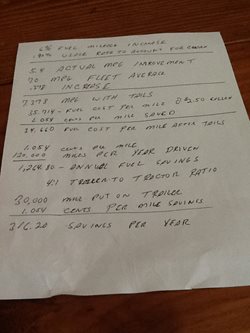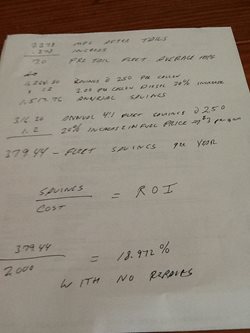Do The Math
 Math is objective. Get the math right and then use your judgment to make the right decision. Results need to be data driven. Data should never be results driven. Don't say that I want trailer tails and then do the math. Do the math and then decide if trailer tails are right for your operation. I am using trailer tails as an example, but the mathematics could hold true in deciding to buy wheel covers, trailer skirts or any other money saving devices. They save fuel. They cost money. The answer you are seeking is does the fuel savings mathematically justify the initial investment.
Math is objective. Get the math right and then use your judgment to make the right decision. Results need to be data driven. Data should never be results driven. Don't say that I want trailer tails and then do the math. Do the math and then decide if trailer tails are right for your operation. I am using trailer tails as an example, but the mathematics could hold true in deciding to buy wheel covers, trailer skirts or any other money saving devices. They save fuel. They cost money. The answer you are seeking is does the fuel savings mathematically justify the initial investment.
Get the objective part right. Do research. Remember that every operation is different. Trailer tails make an interesting example. Claims are between a 5 – 7 percent fuel savings. I know that Albert Transportation has shown about a 6.8% MPG increase since installing trailer tails on his trailer. His operation is different than mine. He has a longer length of haul. He has only one trailer. His driver will always open the tails. A fleet owner might expect about 90% of their drivers to open the tails. That has to be taken into consideration. Damage and maintenance costs also have to be taken into consideration. The price of fuel is volatile. That is a factor. You may want to consider doing the math with various fuel prices.
You need to set up the equation. Use the factors that you know or can estimate with reasonable accuracy. I will use an initial cost of $2,000, a 6% MPG increase, a 90 % usage factor. Everything should be broken down into as small a unit as possible. I will use cents per mile. A one truck owner operator with one trailer could average 120,000 miles per year. A fleet with a 4:1 trailer to tractor ratio would average significantly less. Using a cents per mile equation helps with the actual decision.
For the purposes of this equation I will use a fleet average of 7 mpg. Use your own fleet's numbers. Using a 6% increase with a 90% usage computes to a 5.4% increase. Your MPG would increase to 7.378. When fuel is selling for $2.50 per gallon your fuel cost per mile would go from 35.714 cents per mile to 33.885 cents per mile. It would save you 1.054 cents per mile. At 120,000 miles per year your cost savings would be  $1,264.80 per year. Take away 100 for maintenance and repairs and you come up with a $1,164.80 savings if you leave it folded up 10% of the time. Your return on investment (ROI) would be a significant 58%. That fleet with a 4:1 ratio would drop to a 14.6% ROI. A fuel increase to $3 would increase your ROI proportionally. The ROI for that 1 trailer owner op would increase to almost 70 %. The fleet's would increase to 17.52%.
$1,264.80 per year. Take away 100 for maintenance and repairs and you come up with a $1,164.80 savings if you leave it folded up 10% of the time. Your return on investment (ROI) would be a significant 58%. That fleet with a 4:1 ratio would drop to a 14.6% ROI. A fuel increase to $3 would increase your ROI proportionally. The ROI for that 1 trailer owner op would increase to almost 70 %. The fleet's would increase to 17.52%.
I don't believe in “no brainers”. All of your decisions should be rational and use your numbers. Some decisions are easier than others. Take my company for example. We have a significant number of CNG trucks. They have a lower cents per mile cost than our diesels. How long do you keep a trailer? That is a factor. Some of our trailers are local. Putting trailer tails on those may be a losing proposition. Segregating the local trailers would increase ROI. Then you might get an aggravated driver who can't find a road trailer to load and be staring at a local trailer. A company president is paid more than their stats guys for a reason.